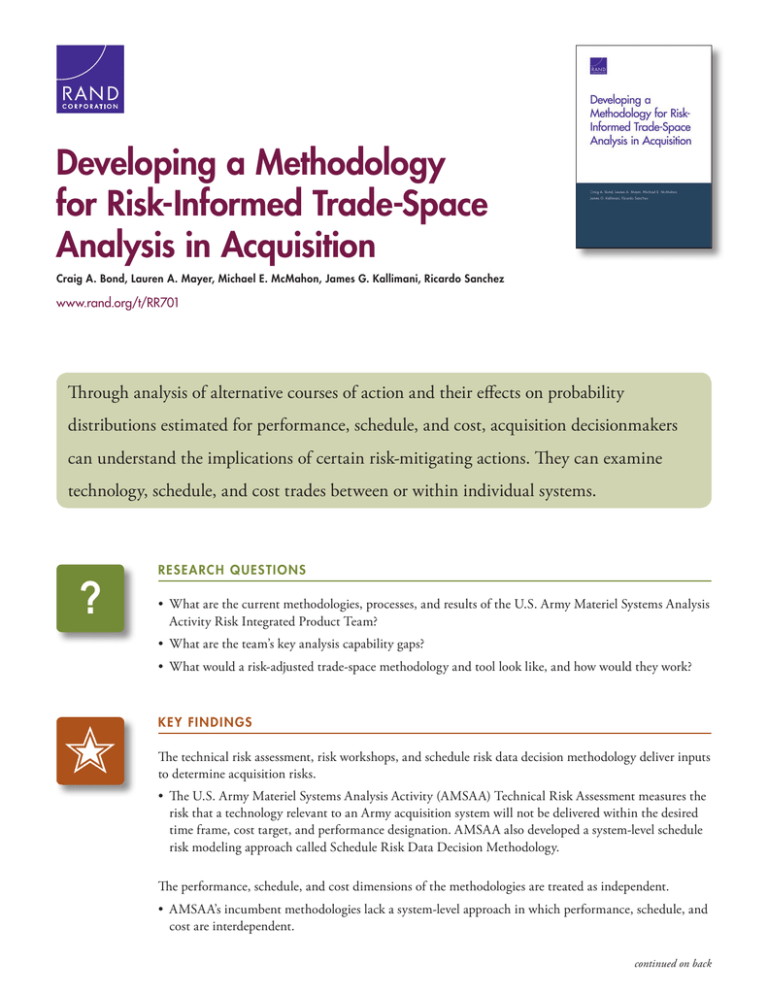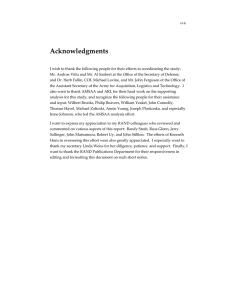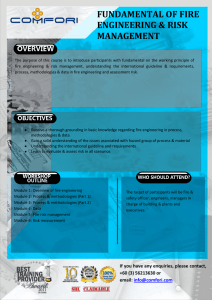Developing a Methodology for Risk-Informed Trade-Space Analysis in Acquisition
advertisement

C O R P O R AT I O N Developing a Methodology for Risk-Informed Trade-Space Analysis in Acquisition Craig A. Bond, Lauren A. Mayer, Michael E. McMahon, James G. Kallimani, Ricardo Sanchez www.rand.org/t/RR701 Through analysis of alternative courses of action and their effects on probability distributions estimated for performance, schedule, and cost, acquisition decisionmakers can understand the implications of certain risk-mitigating actions. They can examine technology, schedule, and cost trades between or within individual systems. ? RESE A RC H Q U ESTI O NS • What are the current methodologies, processes, and results of the U.S. Army Materiel Systems Analysis Activity Risk Integrated Product Team? • What are the team’s key analysis capability gaps? • What would a risk-adjusted trade-space methodology and tool look like, and how would they work? ✭ K E Y FI N D I N GS The technical risk assessment, risk workshops, and schedule risk data decision methodology deliver inputs to determine acquisition risks. • The U.S. Army Materiel Systems Analysis Activity (AMSAA) Technical Risk Assessment measures the risk that a technology relevant to an Army acquisition system will not be delivered within the desired time frame, cost target, and performance designation. AMSAA also developed a system-level schedule risk modeling approach called Schedule Risk Data Decision Methodology. The performance, schedule, and cost dimensions of the methodologies are treated as independent. • AMSAA’s incumbent methodologies lack a system-level approach in which performance, schedule, and cost are interdependent. continued on back The Risk-Informed Trade Analysis Model (RTRAM) and methodology provide a system-level approach to acquisition risk. • RTRAM and its underlying methodology provide an approach to quantitatively and consistently estimate output distributions related to performance, schedule, and cost based on AMSAA’s risk workshop and previously developed methodologies. It allows users to investigate multidimensional trade-offs both within and between weapon systems prior to production, using elements of system engineering, production economics, and risk analysis to functionally and probabilistically relate performance, schedule, and cost outcomes and their related uncertainties holistically and understandably. To Do R ECOM M EN DATI O NS • AMSAA should develop and integrate baseline-independent technical performance metrics into the risk workshop process. These measures could be objective and relative to an appropriate measurement scale where available, objective and relative to a baseline technology, or subjective and relative to a baseline technology. The important attribute of such measures is that they can be used to compare alternative technologies relative to some standardized baseline. • The team needs a continuous distribution that describes stochastic system-level schedule outcomes, rather than the discrete probability and consequence of not meeting a particular deadline for a particular technology. Also, the three broad outcomes of interest are functionally interrelated, at both the technology and the system levels. Ideally, a fully formed trade-space analysis should recognize these interconnections, such that any proposed changes in design variables percolate through all outcomes in each dimension. • Because current Army costing procedures do not typically incorporate explicit structural relationships between performance, schedule, and cost estimates and the task of performing cost analysis typically falls to different organizations that perform technical and schedule analysis, the team needs to develop additional cost methodologies that are consistent with the technological and schedule risks. A RRO YO CENT ER RAND Arroyo Center is the Army’s federally funded research and development center for studies and analyses. Its mission is to help Army leaders make decisions that are informed by objective, high-quality analysis. For more information visit Arroyo’s website at www.rand.org/ard.


